Terik tahu tempe is a traditional Indonesian dish that is accidentally vegan. It is rich in coconut milk, with a hint of sweetness and traditional Indonesian spices. If you are bored with your regular cooking method for tofu and tempeh, try this recipe.
If you grow up eating Indonesian food, you should realize there are many types of curry, and terik is one of them. Other types of curry in Indonesia are gulai (view my jackfruit gulai recipe here), lodeh, and opor (I will share both recipes later in another post).
Table of Contents
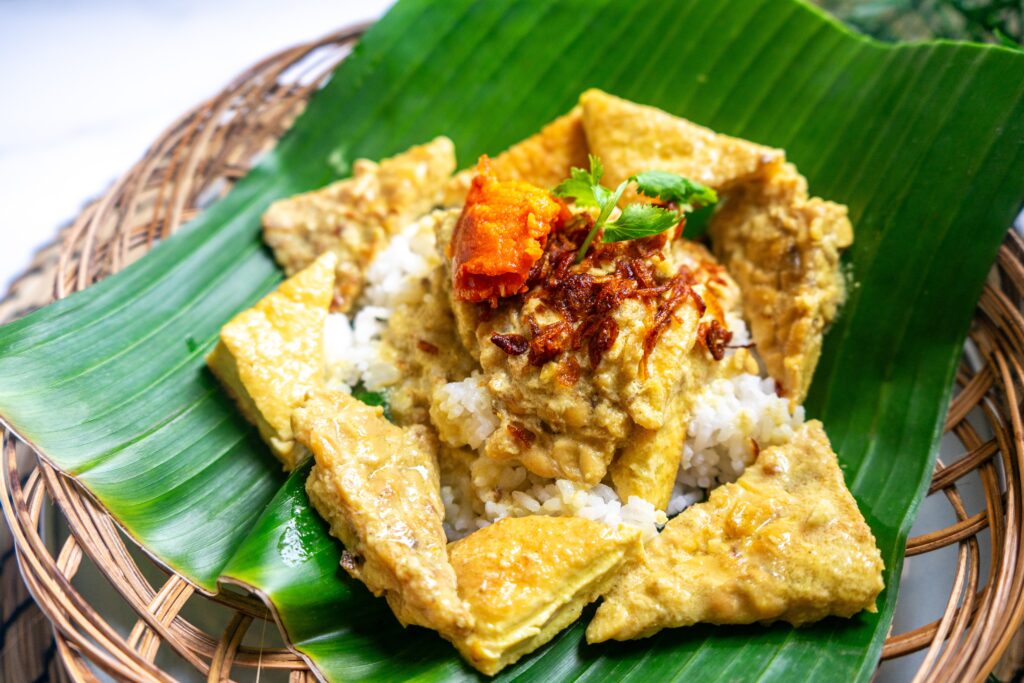
“I have no idea what Terik Tahu Tempe is”
Yes, it’s understandable. I’m not even sure most Indonesians know this if they are not Javanese (those who originate from Java island in Indonesia). This dish originated in Central and East Java. I know this food because my mom comes from a city in Central Java called Solo or Surakarta.
As I mentioned, terik is like a curry because the main ingredients, tofu and tempe, are simmered in rich coconut milk. The specific things about this dish are reducing the sauce and making it cling to the main ingredient. These things differentiate it from other types of curry in Indonesia. Terik’s key differentiator spices are galangal, coriander seeds, and candle nut. We don’t use lemongrass in this recipe, like gulai and poor.
I have never eaten terik tahu tempe by itself since the taste is usually pretty intense. You can eat it on top of rice or Jenang (Indonesian porridge). The best condiments for this terik tahu tempe are usually fried shallots and Indonesian sambal (here is my favorite sambal recipe).
Why Terik Tahu Tempe is Worth Trying
Terik Tahu Tempe is not just another tofu and tempeh dish—it’s a flavorful journey into the heart of Javanese cuisine. Here’s why you’ll fall in love with this comforting classic:
- Perfect Harmony of Flavors
The blend of coconut milk, spices, and aromatics in Terik Tahu Tempe creates a rich, savory, slightly sweet, and deeply satisfying dish. Every ingredient complements the other, from the creamy coconut milk to the tender tofu and nutty tempeh. The hint of sweetness from palm sugar and the aroma of bay leaves and lemongrass elevate this dish into a flavorful masterpiece. - Plant-Based Goodness
If you’re looking for a delicious, protein-rich vegetarian or vegan dish, Terik Tahu Tempe is the answer. Tempeh is a nutritional powerhouse, packed with protein, fiber, and vitamins, while tofu is a versatile source of plant-based protein. Combined with the healthy fats in coconut milk, this dish offers a wholesome and filling meal that’s as nourishing as it is tasty. - A Taste of Indonesian Heritage
Terik Tahu Tempe carries the soul of Javanese home cooking. Preparing and eating it connects you to generations of Indonesians who have lovingly cooked this dish for their families. It’s a cultural experience that gives you a deeper appreciation for the rich culinary traditions of Indonesia. - Versatile and Customizable
The beauty of Terik Tahu Tempe lies in its flexibility. Add boiled eggs for extra richness or young jackfruit for a unique twist. Would you prefer a spicier kick? Pair it with a sambal for added heat. Whether you’re cooking for a family dinner, a potluck, or meal prepping for the week, this dish adapts beautifully to any occasion. - Easy Yet Impressive
While Terik Tahu Tempe looks and tastes complex, it’s surprisingly simple to prepare. With a few basic steps—frying the tofu and tempeh, simmering the coconut milk with spices, and letting everything meld together—you’ll have a restaurant-quality dish right from your kitchen. - Perfect Pairing with Steamed Rice
The thick, creamy sauce of Terik Tahu Tempe is designed to be enjoyed with warm steamed rice, making it a comforting meal that satisfies cravings and warms the soul. The dish’s mild flavors also match it for other Indonesian favorites, like sambal goreng or a simple side of blanched vegetables. - Crowd-Pleaser
Whether introducing someone to Indonesian cuisine or cooking for those who already love it, Terik Tahu Tempe is a dish that impresses everyone. It’s hearty and flavorful enough for meat lovers to delight anyone seeking plant-based options.
The ingredients for Terik Tahu Tempe
Tempeh
I need to make an important remark here: You don’t have to use both! If you don’t have tempeh or don’t like tempeh, please feel free to use tofu only. The same goes for tofu. I like both, so I definitely want to use both. It is nice to have extra texture in a plate, which is a combination of light flavor and softness from tofu with an interesting texture from tempeh (tbh, I’m not sure how to describe the tempeh texture)
For you who don’t know what tempeh is: It is a fermented soybean. The white part of tempeh is a fungus, Rhizopus oligosporus or Rhizopus oryzae, which is used in the fermentation process and is also known as tempeh starter (Click here to see my other recipe using tempeh)
Since there are not many tempeh options here in Singapore, I am only able to choose between the block 200gr tempeh or this 80gr size. Either way works fine, so choose whichever is available in your country. If you are in Indonesia, lucky you, as there are many options that you can choose from!
Okay, enough story about tempeh. The preparation thing that you need to do for this tempeh is to cut it to the size that you prefer. I prefer to cut it into this triangle shape (3 cm x 2 cm) because I feel this is the right bite size. After I cut it, I usually make sure I slice each of the surfaces of the tempeh, like in the picture below. The purpose is to create a space so that the seasoning will be easily absorbed by the tempeh.
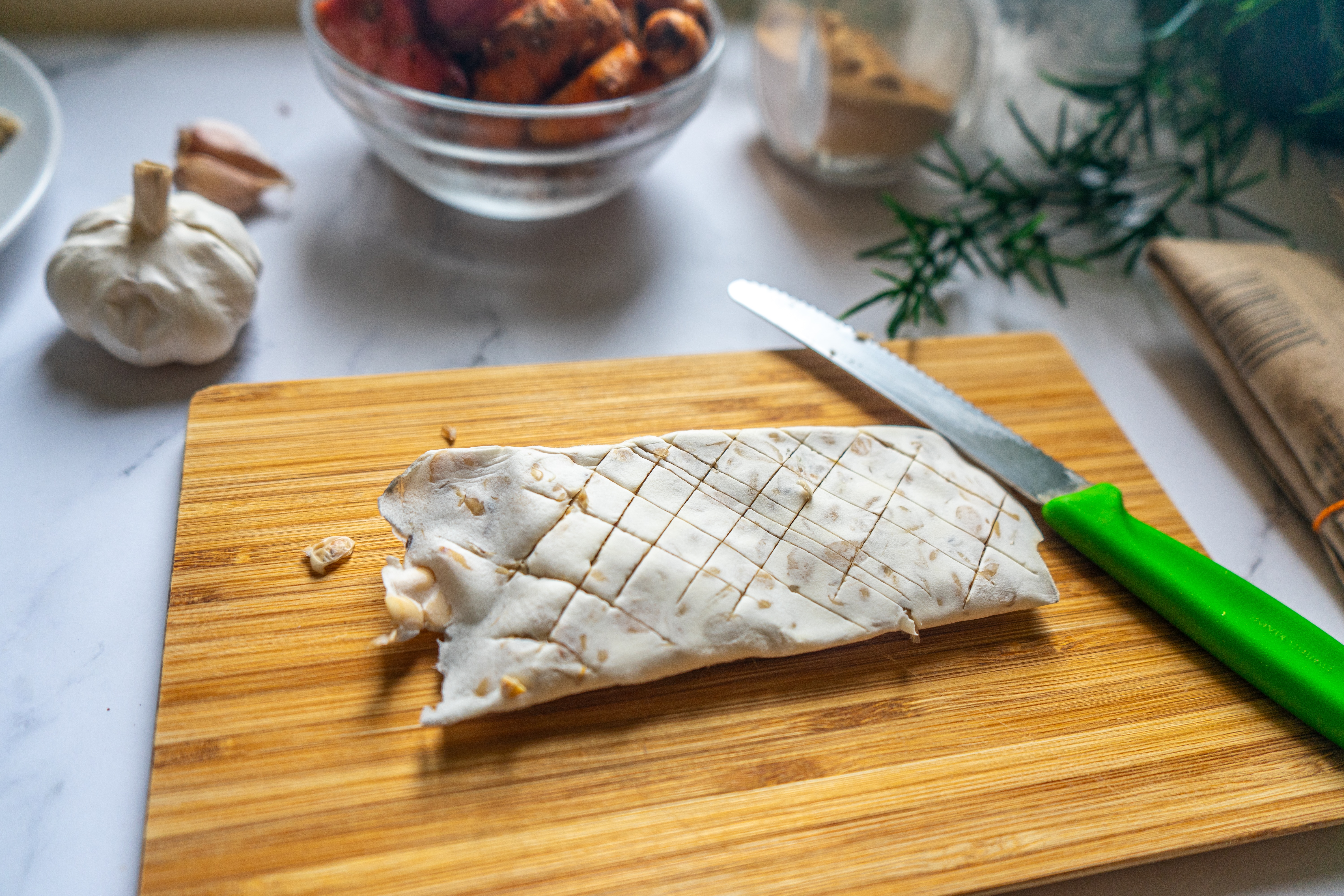

Tofu / Tahu
Tofu and Tahu are the same thing. I guess in Singapore or Western countries, they usually call it Tofu. In Indonesia, we call it Tahu. In Indonesia, we use the term tofu for egg tofu. So, just a disclaimer here for Indonesians: I am going to use tofu and tahu interchangeably, and when I do that, I am referring to the regular tahu (without egg).
Do you all believe that tofu in Indonesia is much better than in Singapore? In Indonesia, you can get fresh tofu every morning if you visit a wet market. It usually comes in a variety of sizes, textures, and colors. In Singapore, I mostly used pre-packaged tofu, which came in the same size and form. But wait, I realized I could try to explore Singapore’s wet/fresh market more. Maybe I can get more fresh and more variety of tofu there.
Similar to tempe, I cut it into roughly the same size triangle, with a length of 3 cm and a width of 2 cm. I tried to match the tofu height with the tempe height but did not make it too thin; otherwise, it would break easily. I do this for homogeneity to look aesthetically pleasing and be homogeneous during eating. Because of the tofu texture, you don’t need to slice the tofu’s surface like a tempeh. It is very fragile. Slicing it will make it break!
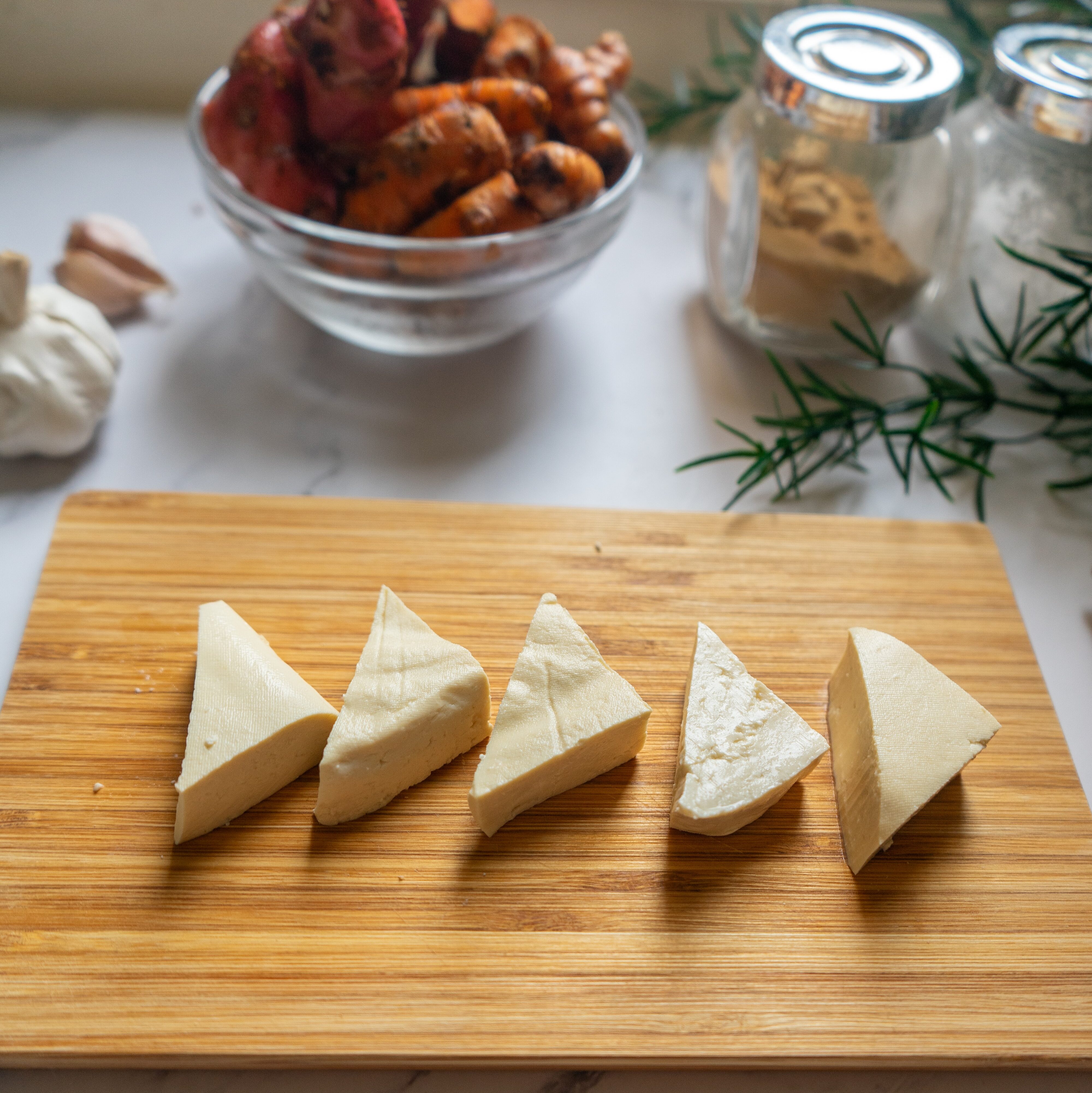
Coconut Milk
There are usually three types of coconut milk: fresh, pasteurized, and sterilized. I will share the differences between these three with my science knowledge. By the way, do you know that I actually have a biology degree even though my work is more in IT now? Even though I am not using it for my work, I use some of my biology knowledge in everyday life. Thus, I am going to share some of it in this post!
Fresh
You can usually get this in the wet/ fresh market. In Indonesia, we can pick the coconut we want. Then, the coconut seller will grate it and, after that, will make the coconut milk. If you worry about hygiene, we can also make the coconut milk by ourselves from the grated coconut. Let me know in the comment section below if you want me to cover this part in another post!
Pasteurized
This usually comes from the factory-packaged coconut milk. You usually can find this type in the chilled area in the supermarket. Pasteurization is the heating process to eliminate bacteria (partially) at less than 100° C; hence, it would not break the protein. It is enough to kill bacteria but not the bacterial spore, which is the state bacteria form when they are in a threatening condition (like the heating process). After a while the spore will turn back into bacteria. That’s why pasteurized milk does not last very long. we must keep it in a chilled environment to further inhibit the bacteria’s growth.
Sterilized
This is also factory-packaged coconut milk, which you can find in the non-chilled area of the supermarket. It might come in cans or carton boxes. Sterilization is the total elimination of bacteria above 100° C. The spores will also be eliminated, so the milk can last longer. However, the trade-off is that some of the protein will break, making it less nutritious than the pasteurized version.
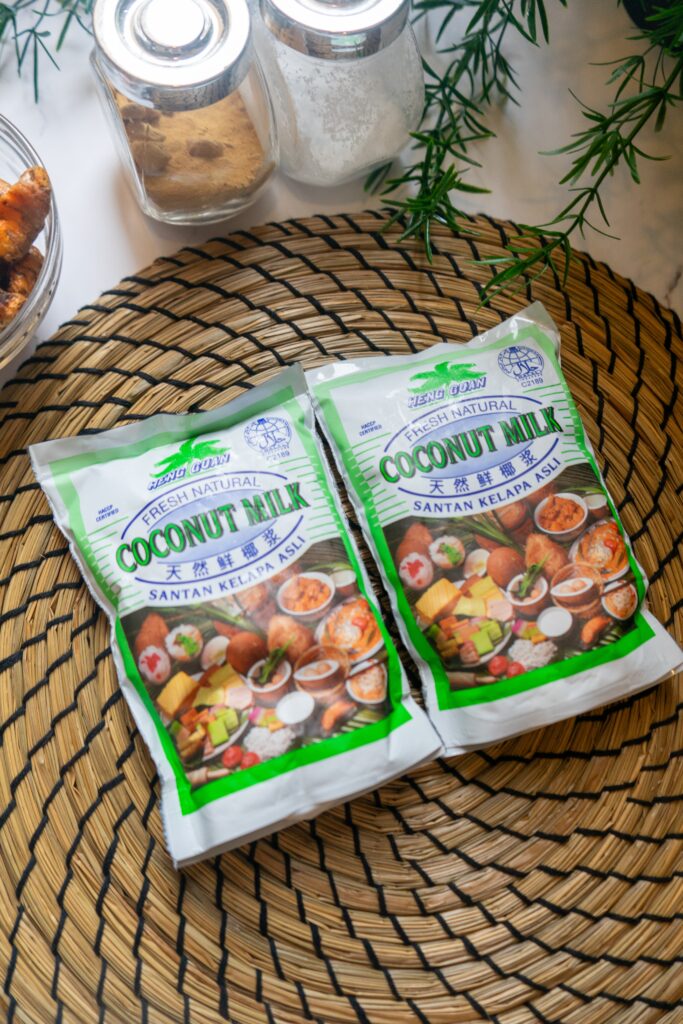
Herbs & Spice
As mentioned in the intro above, the key ingredients for this terik tahu tempe recipe are coriander seeds, candle nuts, and galangal. But I am going to share everything, not only these 3, and why we need them.
Blended Ingredients
- Shallot and Garlic: Shallot and garlic are staples in Indonesian recipes. You always need to have both in your kitchen. It’s pretty rare for Indonesian recipes to use one without the other. Garlic has a strong and pungent flavor, often used in savory dishes to add flavor and depth. Shallots have a milder flavor than garlic, with a hint of sweetness
- Coriander Seeds: For this recipe, you can dry roast the fresh seeds to enhance the flavor, aroma, and pungency, but you don’t have to. Coriander seeds, in general, will add a mild citrusy hint with a slight curry flavor. If you don’t have coriander in your kitchen staples, try substituting it with cumin.
- Candle Nuts: Candlenuts’ high oil content contributes to the gravy’s thickness; therefore, they are added to gudeg Yogya to make this dish thicker, creamier, and slightly oilier. The presence of glutamic acid in candlenuts gives a dish a hint of nutty flavor. The mild bitterness in the candlenuts disappears upon cooking.
- Turmeric: It is great if you have turmeric, but the dish will work fine if you want to skip it. You can use the dry version if you don’t have access to the fresh one. Turmeric is why the curry is yellowish, so I can say it serves as a coloring agent. Turmeric also enhances the flavor of this terik since it is mildly fragrant and has a slight ginger-like bite; however, it is also bitter in quantity, and overuse can make it very unpleasant to eat.
Other Ingredients
- Galangal: Galangal root is a relative of ginger and turmeric since they belong to the same family of plants. Despite belonging to the same family, there are significant differences in appearance, flavor, and texture between galangal and ginger. When young, galangal root is generally smoother and paler than ginger. Though galangal has a sharp taste, it is more citrusy, pine-like, and earthy, and some varieties have an almost minty, camphor-like scent and flavor. Ginger, on the other hand, is peppery with spicier notes. Galangal feels hard, woody, and fibrous, so cooks often discard it from dishes before serving.
- Palm Sugar: This palm sugar balances out all of the other herbs and the savoryness of this dish. It is a small quantity but can really enhance the flavor and make the taste more cohesive. Palm sugar usually comes in block size, so you should shred it with a knife into smaller pieces to make it dissolve easily. You can replace it with brown sugar if you don’t have it.
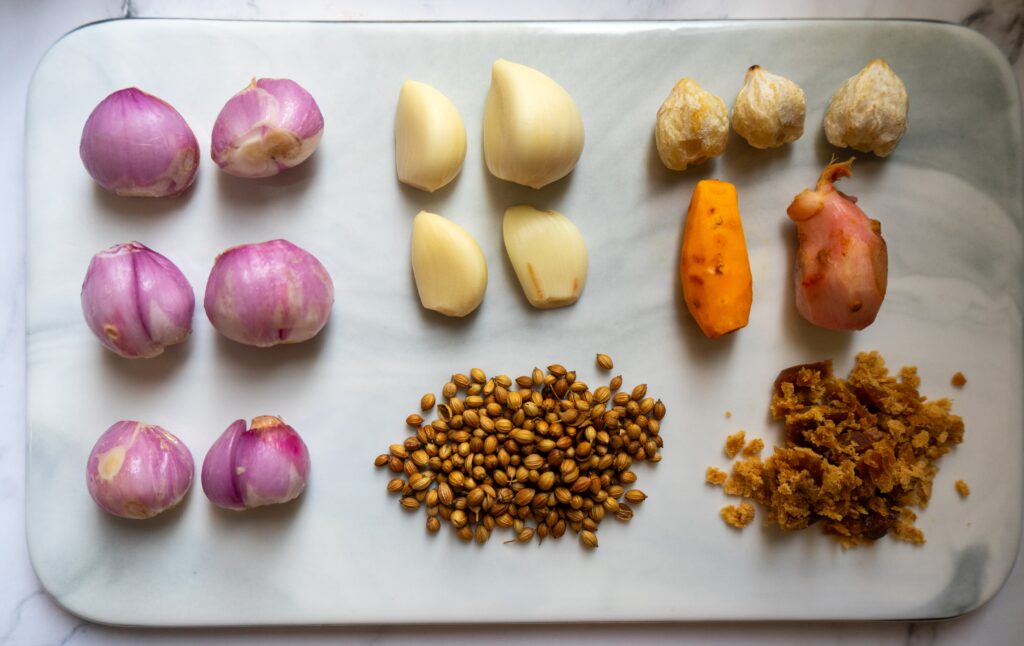
Let’s Start Making Terik Tahu Tempe
1. Pan-fry the Tofu and Tempeh
This is the first step for the terik tahu tempe. Before frying them, cut the tahu/tofu and tempe to your preference (please refer to the ingredients section in this post to read the details). I am roughly cutting them into 3 cm and 2 cm heights for both and trying to equal the tofu and tempe sizes.
After that, pan-fry the tofu and tempe using slight oil (~50ml) until golden brown. I am using an induction stove here, and the temperature I use is 160°. I fry them for around 7-10 minutes. I flip them occasionally so they will be even. Depending on the size of your pan, you might need to do multiple batches like me in order not to crowd the pan. Drain the excess liquid and keep it aside.


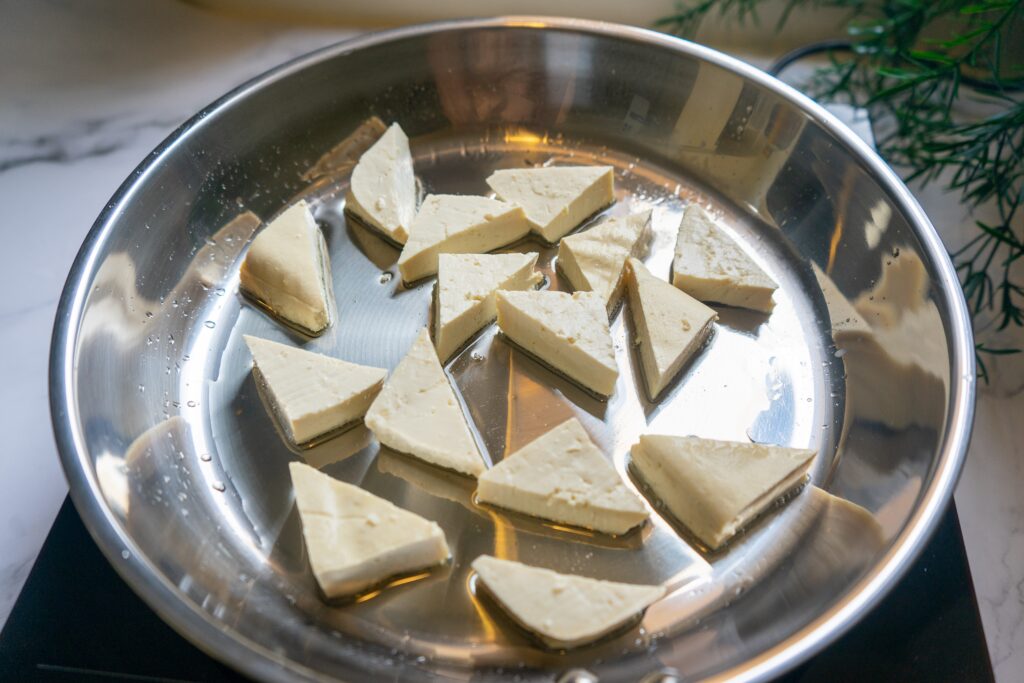
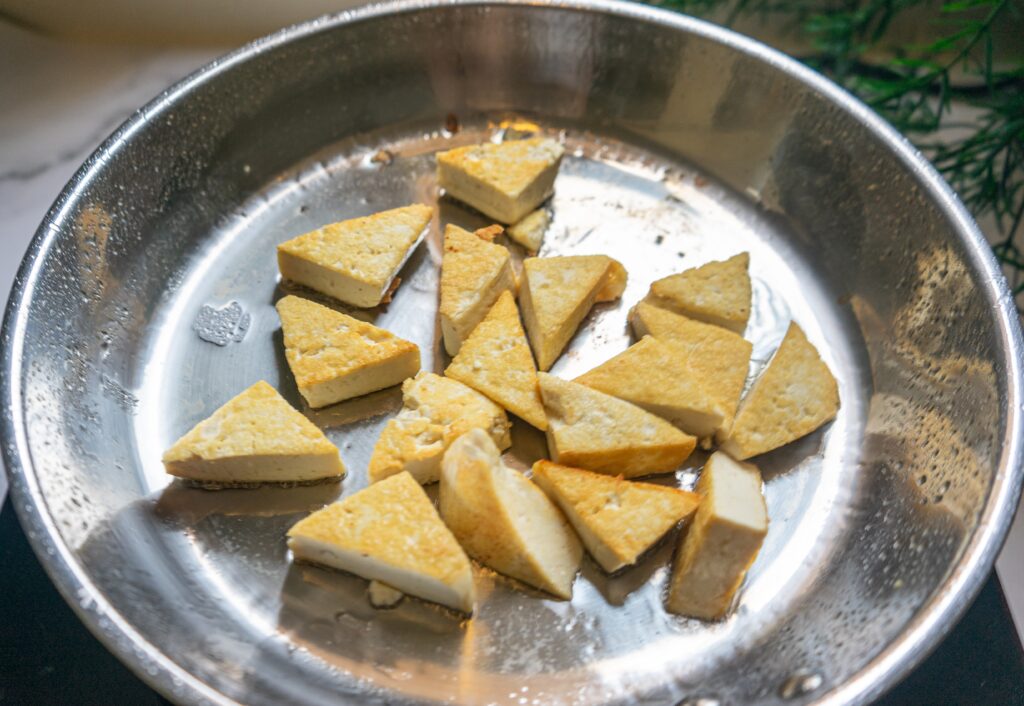
2. Make the Blended Mixture
Blend shallots, garlic, turmeric, galangal, and coriander seeds all together. Please add some oil to help with the blending process; otherwise, it will be too dry, and the mixture will not be smooth. I am using my immersion blender (here is the Amazon link for the type I use). Suppose you don’t have the immersion blender. In that case, you can use any other spice blender (generally any blender that you can use to blend a small amount of the ingredients), or you can do it the traditional way by using the mortal and pestle. Anything that will make them smooth.
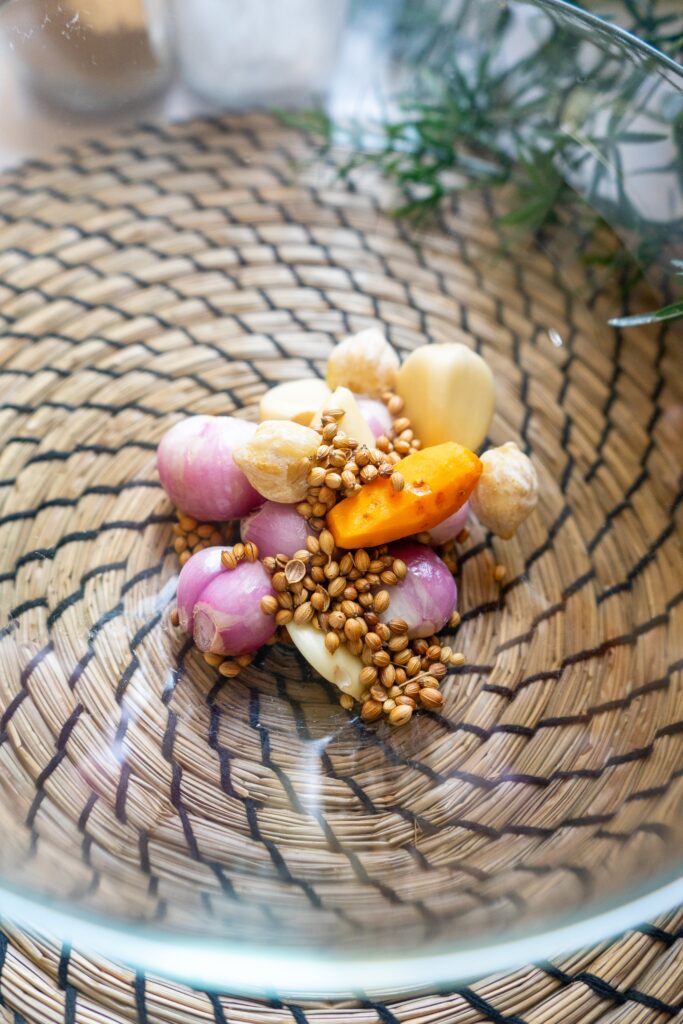
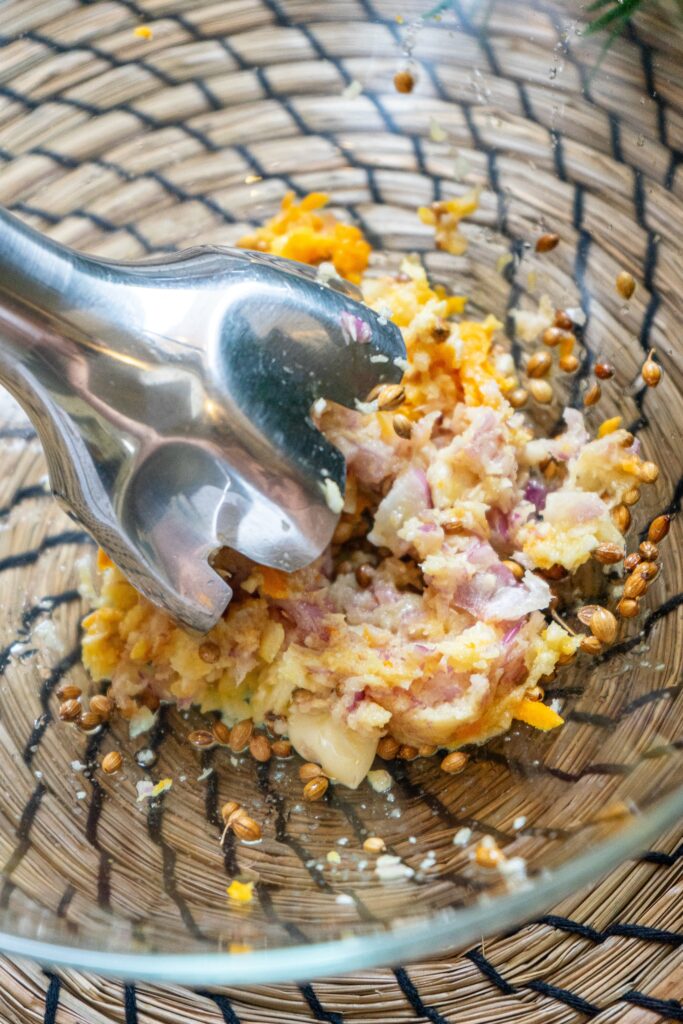
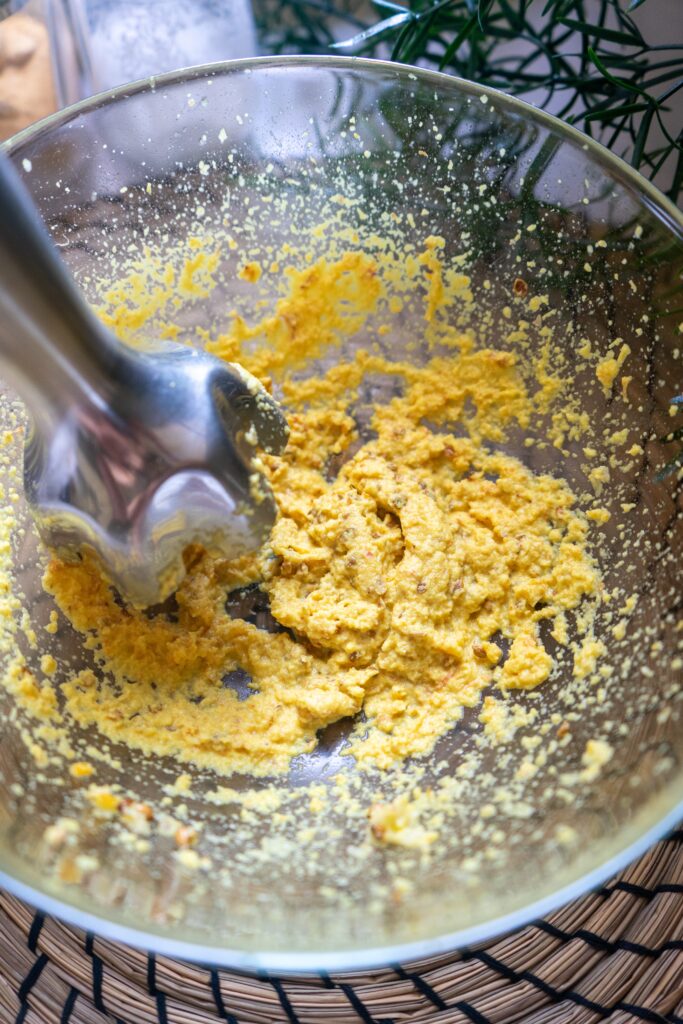
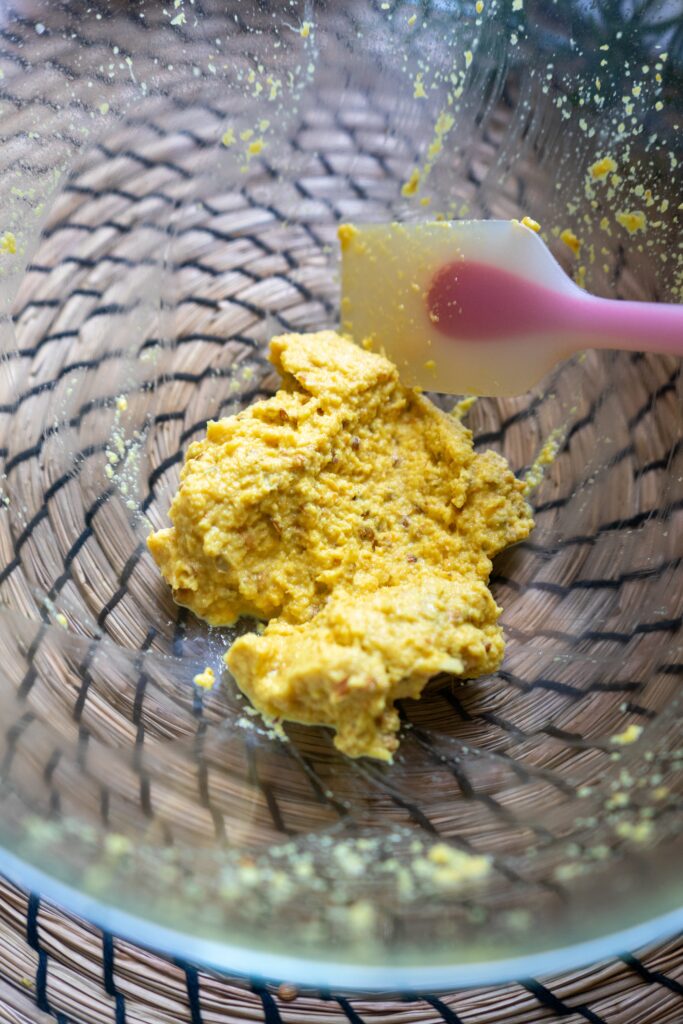
3. Saute the Blended Seasoning Together with Galangal
Heat your pan together with 2 tbsp vegetable oil. The heat setting I use in my induction cooker here is around 120°. Put the blended mixture into the pan together with the galangal. Saute them until the fragrance or until all of the herbs are fully cooked. Please don’t leave the pan during this stage. Continue mixing it using the spatula to make sure everything is evenly cooked. If you forget to sauté your candle nuts before you blend them, you need to saute them longer. Ensure you don’t overdo it until all the herbs are blended.
Note:
- The blended mixture might stick to the pan during this step. Don’t worry if it is happening. I am using non-stick stainless steel, but it still sticks. Just continue mixing and scraping some of the sticking parts.
- If your mixture still smells “herb-y,” but some of it starts browning, and you are worried about overcooking, do not worry. Just continue to the next step, and we will have a chance to get rid of this herb smell.
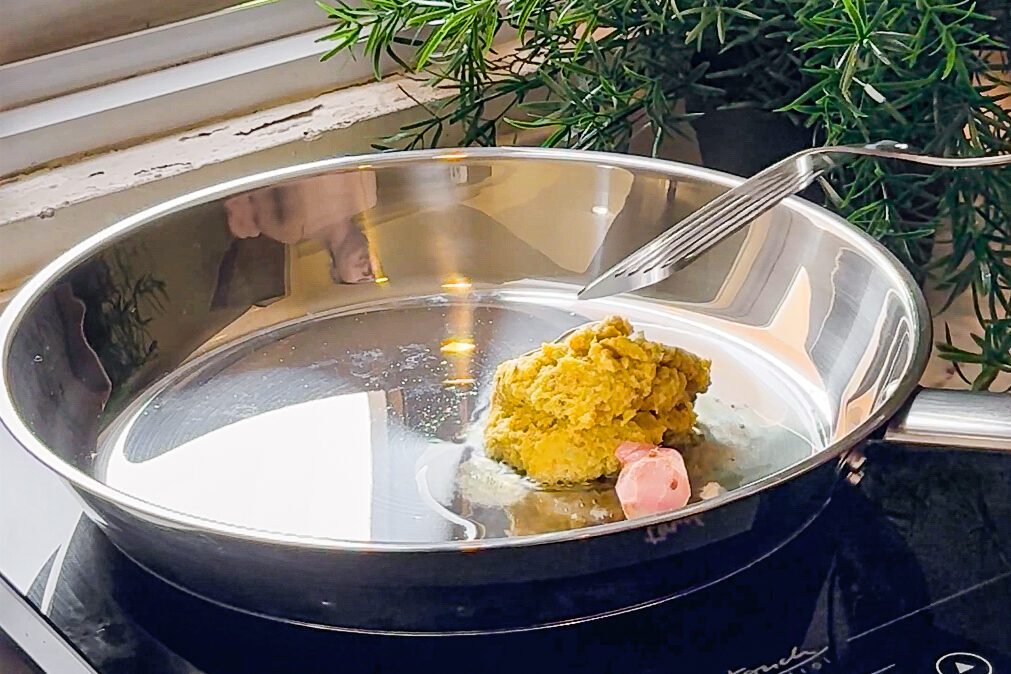
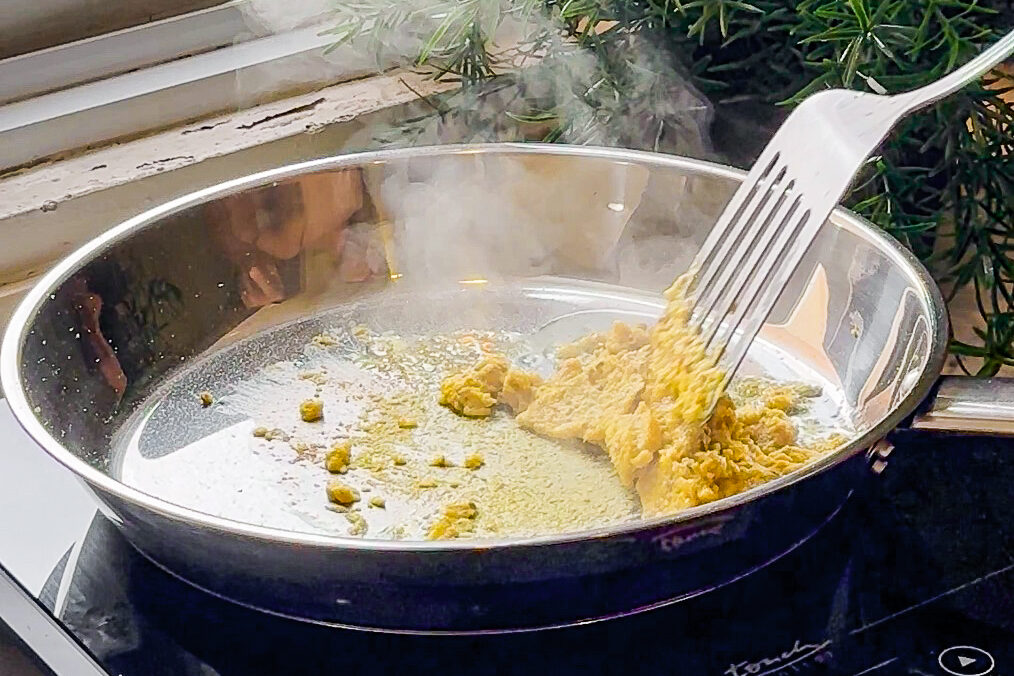
4. Add the Coconut Milk and the Rest of the Ingredients
Put inside the coconut milk, palm sugar, salt, and mushroom stock. Mix them evenly with a spatula until all the palm sugar is dissolved.
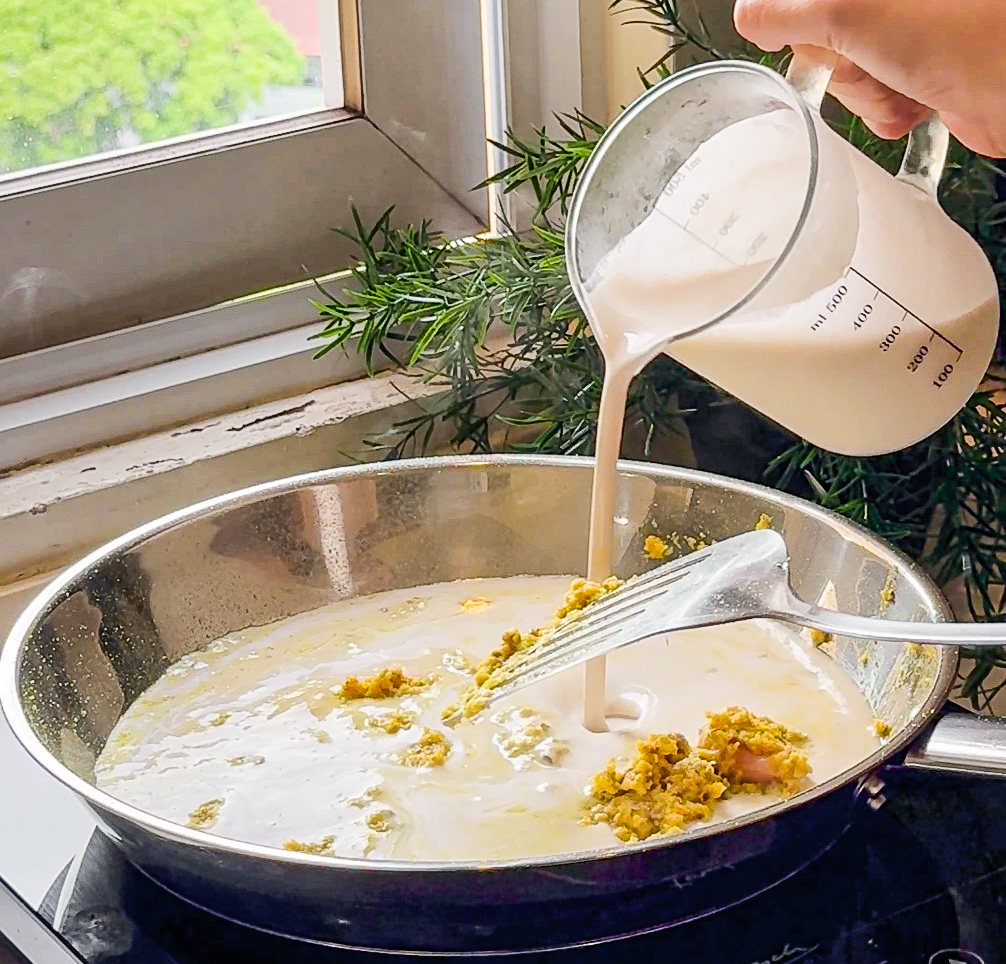
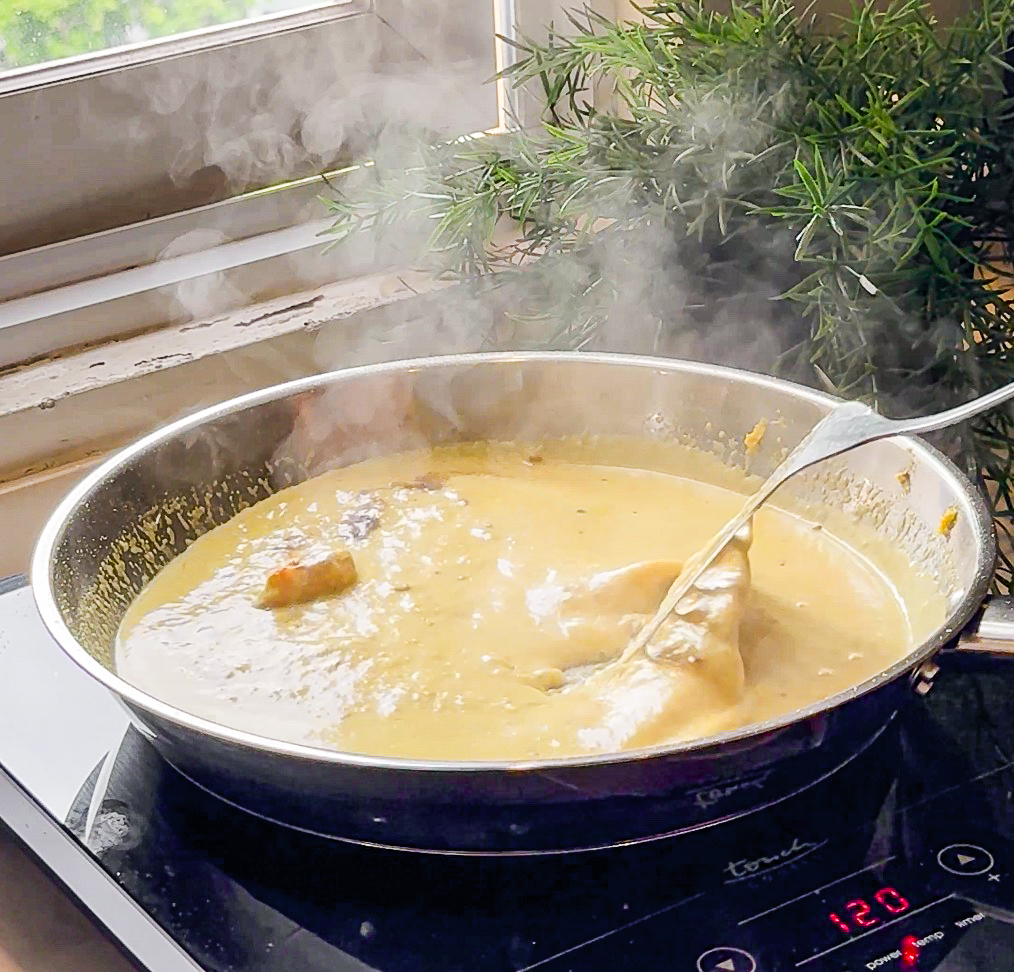
5. Put Inside the Tahu and Tempe into the Terik Gravy
Add the fried tofu and tempe into the gravy. Mix all of them together. Please add more water if not all the tofu and tempe are fully submerged. Continue adjusting the seasoning (salt and mushroom stock) occasionally, depending on the quantity of water you add. Cover the pan with a lid, and let it cook until the gravy is thickened and does not smell herby anymore. After that, you can turn off the stove and serve 
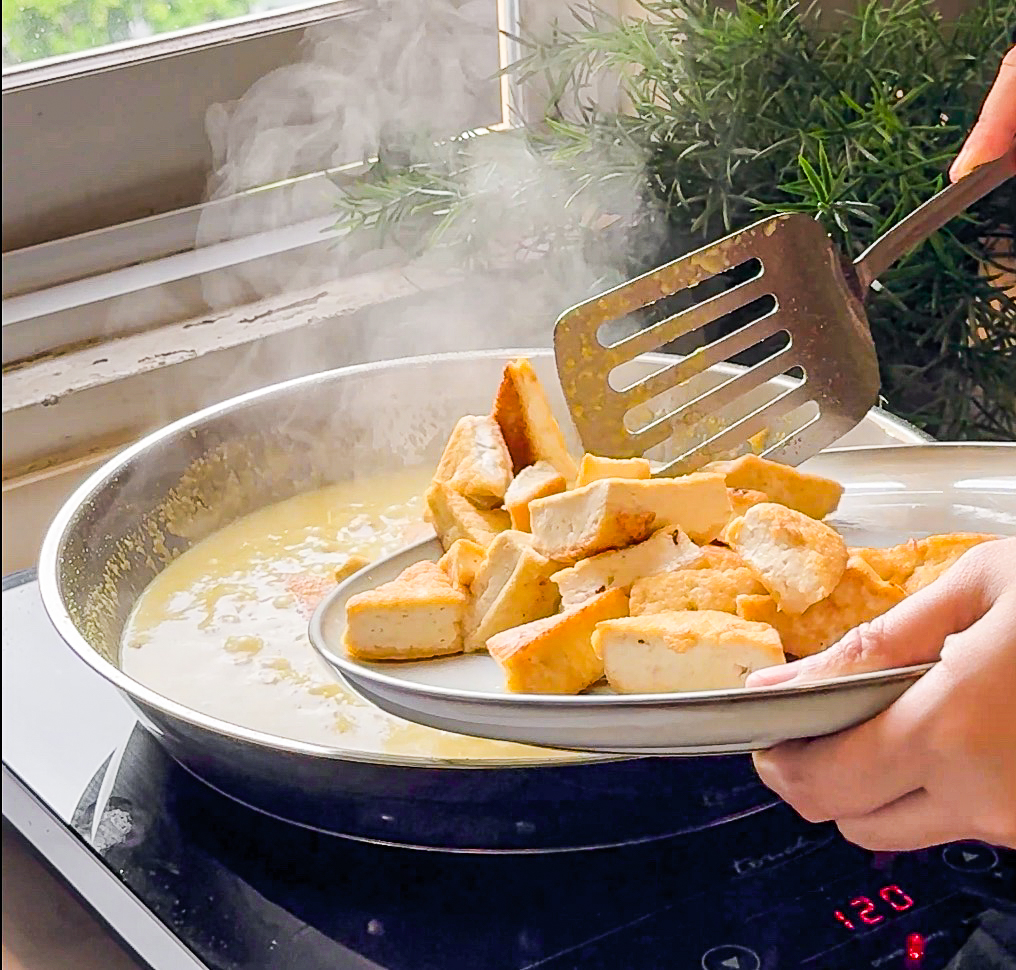

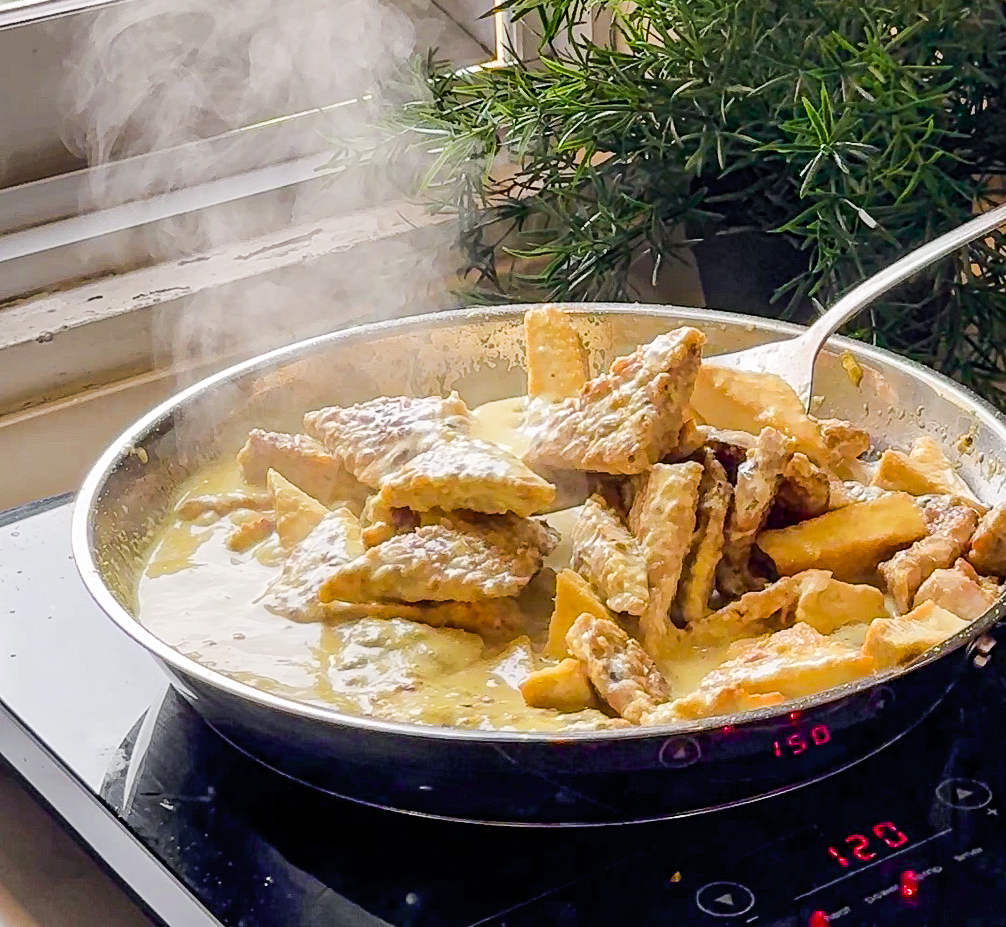
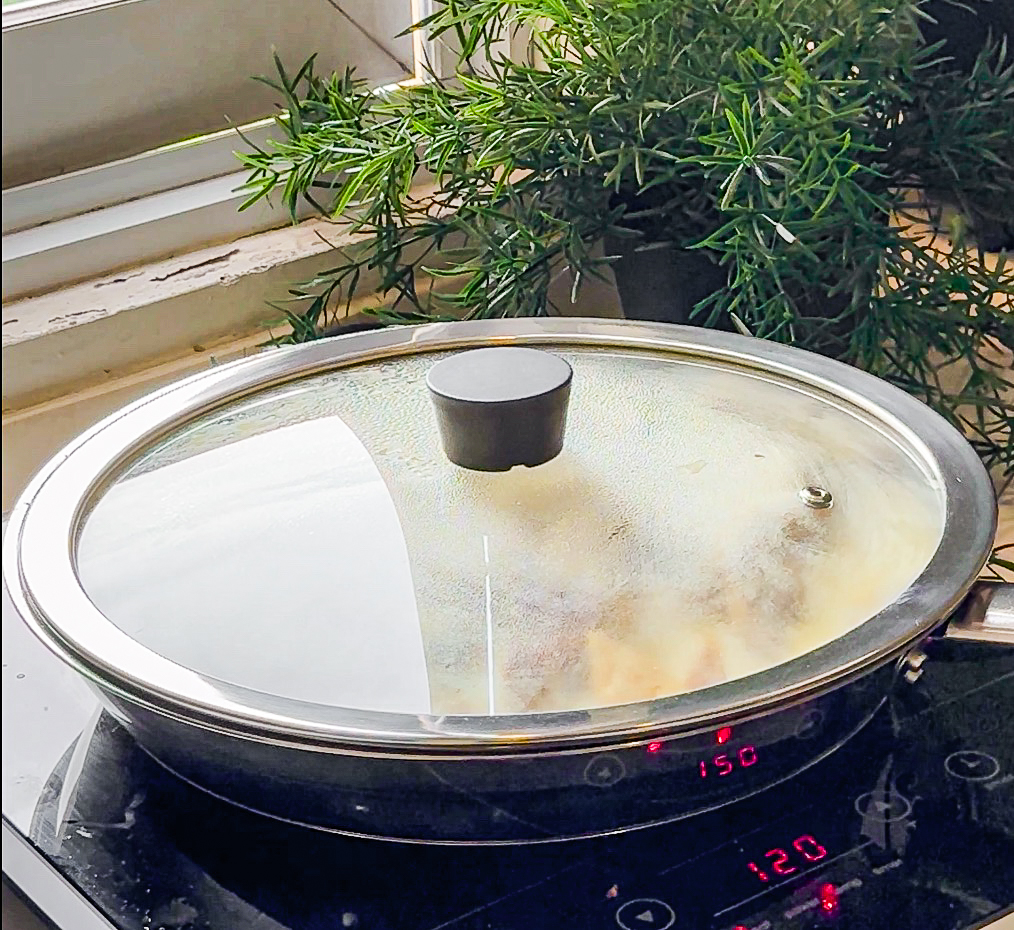
Storing Instruction for Terik Tahu Tempe
If you have leftover terik tahu tempe, there are two ways to store it: the regular and traditional Indonesian ways. I usually use the conventional method, but it depends on your comfort level and preference.
Regular Method
The regular method is simple: put the dish into the food container and store it in the fridge. It will be suitable for up to 5-7 days. You should thaw it before consuming it by heating it in a microwave for 1-2 minutes.
Traditional Indonesian Method
The traditional Indonesian way probably is a little bit unusual for you. I guess people used it in the past because they didn’t have refrigerators and/or microwaves. The technique here is to keep it in the pot, but you have to reboil it until it bubbles twice a day:
- The first is at night. After this nighttime boil, please ensure the gulai is not stirred by any spoon.
- The second is in the morning. There are no restrictions on the no-stirring policy after this.
The boiling process aims to eliminate the bacteria that will make the gulai turn bad (similar to the sterilization process). The no-stirring policy aims to ensure that no new bacteria are reinduced. However, it works. If you forget to boil it once, your terik will turn sour, and you don’t want that to happen! This method will make the gulai last for 3-4 days.
I usually prefer this method because the boiling process makes the terik tahu tempe taste even better on the second day! The seasoning and gravy soak into the tofu and tempe, making the dish rich.
Cooking Tips for Making the Perfect Terik Tahu Tempe
Crafting an authentic Terik Tahu Tempe is about getting the right flavors and textures. Here are some tips to help you master this comforting Javanese dish:
1. Lightly Fry Tofu and Tempeh First
- To get the best texture for your Terik Tahu Tempe, lightly fry the tofu and tempeh before simmering them in the coconut milk sauce. This step enhances their flavor and helps them hold their shape during cooking.
- Tip: Drain the fried tofu and tempeh on paper towels to remove excess oil, ensuring a lighter dish.
2. Blend Your Spice Paste Thoroughly
- The spice paste is the heart of Terik Tahu Tempe. It blends fresh ingredients like shallots, garlic, candlenuts, and coriander into a smooth paste, ensuring an even distribution of flavors throughout the dish.
- Tip: If your blender struggles, add oil or water to help achieve the perfect consistency.
3. Choose High-Quality Coconut Milk
- Coconut milk is the star ingredient in Terik Tahu Tempe, so for the most decadent flavor, choose fresh or high-quality canned coconut milk.
- Tip: Stir the coconut milk well before adding it to the pot to ensure even consistency in the sauce.
4. Simmer Low and Slow
- The creamy sauce of Terik Tahu Tempe develops its full flavor when simmered gently over low heat. This allows the spices to meld beautifully with the tofu and tempeh.
- Tip: Stir occasionally to prevent the coconut milk from curdling or sticking to the pan.
5. Balance Sweetness and Savory Notes
- A perfect Terik Tahu Tempe balances the natural sweetness of palm sugar with the savory depth of salt. Taste and adjust these seasonings gradually to find your ideal flavor profile.
- Tip: If palm sugar isn’t available, substitute with brown sugar or gula malaka for a similar taste.
6. Add Aromatics for Depth
- Key aromatics like bay leaves, lemongrass, and galangal give Terik Tahu Tempe its signature flavor. These ingredients infuse the sauce with earthy and citrusy notes that elevate the dish.
- Tip: Slightly bruise the lemongrass to release its oils for a more aromatic dish.
7. Use Fresh Ingredients
- For the best-tasting Terik Tahu Tempe, use fresh spices like shallots, garlic, and galangal. Avoid pre-ground spices, which can lack the vibrant flavor of freshly prepared ones.
- Tip: Freeze any leftover fresh spices to extend their shelf life without losing their potency.
8. Thicken the Sauce Gradually
- The sauce in Terik Tahu Tempe should be thick enough to coat the tofu and tempeh. If the sauce doesn’t thicken as desired, let it simmer uncovered for a bit longer.
- Tip: Reducing the water in your spice paste can also help achieve a thicker consistency.
9. Let It Rest Before Serving
- Like many traditional Indonesian dishes, Terik Tahu Tempe tastes even better after resting. To deepen the flavors, allow it to sit for 10–15 minutes after cooking.
- Tip: Leftovers are even more flavorful, so don’t hesitate to save some for the next day!
10. Pair It with the Right Sides
- Terik Tahu Tempe shines when served with steamed rice. Add sambal or fresh vegetables like cucumber and boiled spinach to balance the dish’s creamy richness for a spicy kick.
- Tip: Pair it with other Javanese classics like sambal goreng or opor ayam for a festive touch.


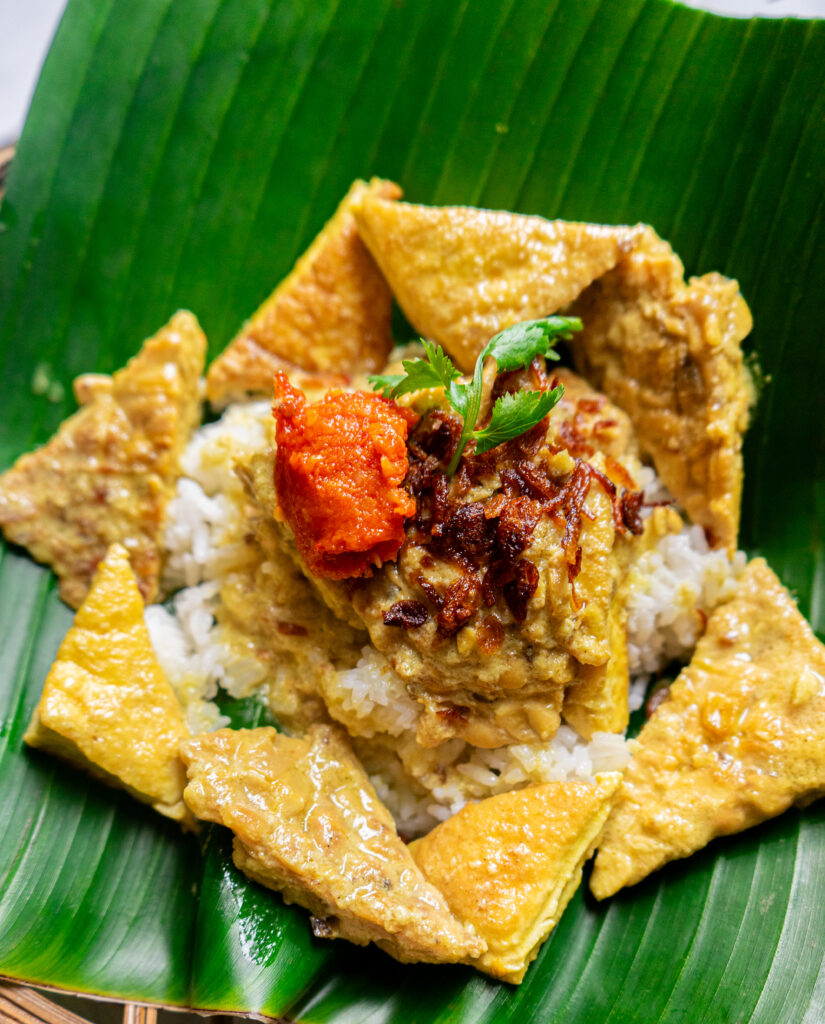
1 comment
[…] Vegan […]
Comments are closed.